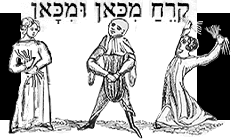|


| "….Said
Rabbi Nappaha: 'I will tell you a parable. To what can it
be compared? To a man with two wives, one young, one old.
The young one pulls out his white hairs, while the old one
pulls out his black hairs, and thus he becomes bold from either
side!'" (BT Baba Kama 60b) |
In the Talmud,
Rav Ammi and Rav Assi, two sages often quoted together, are studying
with Rabbi Yizhak Nappaha. Each student wants his mentor to teach
the material that he enjoys most: One asks for legend (midrash),
the other for law (halakhah). Rabbi Yizhak is caught in
a bind. When he start to teach midrash, one student interrupts
and asks his teacher for law. But when Rabbi Yizhak switches to
law, the other student prevents him from continuing, for he prefers
legend.
Being a master
teacher, Rabbi Yizhak resorts to the use of a parable to explain
his predicament: A man with two wives, one young and one old,
would have one of them wanting him to look more youthful and the
other desiring a more mature husband. Although each wife pulls
out only some of his hair, the result is that the man is left
"bald from both sides." (In the subsequent passage,
Rabbi Yizhak demonstrates his outstanding teaching abilities,
by finding one biblical verse that serves the purpose of both
a midrash and a law, thus satisfying both students.)

The
expression "bald from either side" is used in modern
Hebrew
to suggest a "no-win" or "Catch-22" situation.
 |
 From:
Swimming in the Sea of Talmud: Lessons for Everyday Living,
by Michael Katz & Gershon Schwartz (JPS, 1998)
From:
Swimming in the Sea of Talmud: Lessons for Everyday Living,
by Michael Katz & Gershon Schwartz (JPS, 1998) |
HAIR
Table of Contents
|



